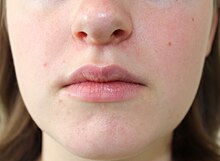History and Terminology
- Perioral dermatitis first appeared in 1957 with a case of light sensitive seborrhoeid.
- By 1964, the condition became known as perioral dermatitis in adults.
- In 1970, the condition was recognised in children.
- There has been ongoing debate about whether all rashes around the mouth are perioral dermatitis.
- Some propose renaming the condition to periorificial dermatitis.
Signs and Symptoms
- Symptoms of perioral dermatitis include stinging and burning sensations.
- Itching is less common.
- The rash is often steroid responsive and may initially improve with the application of topical steroids.
- The redness associated with perioral dermatitis has been linked to depression and anxiety.
- The rash consists of small papules and pustules around the mouth, nose, and sometimes cheeks.
Causes and Triggers
- The exact cause of perioral dermatitis is unclear.
- Topical steroids and cosmetics play a significant role in its development.
- Light exposure has been discounted as a causal factor, but some reports suggest a connection with Psoralen and ultraviolet A therapy.
- Inhaled corticosteroids can trigger perioral dermatitis.
- Drying agents, such as benzoyl peroxide and tretinoin, can aggravate the condition.
Corticosteroids
- Perioral dermatitis often occurs after the use of topical steroids on the face.
- Discontinuing steroids may initially worsen the condition and lead to dependency.
- Inhaled corticosteroids can also trigger perioral dermatitis.
- The condition tends to occur on drier parts of the face and can be aggravated by drying agents.
- There are no comedones present in perioral dermatitis.
Treatment and Prognosis
- Perioral dermatitis can resolve without medication by avoiding irritants.
- Topical corticosteroids should be completely stopped if possible.
- If necessary, a less potent topical corticosteroid may be temporarily used.
- Medications such as tetracycline, doxycycline, and erythromycin can speed up recovery.
- Erythromycin can be used as a cream for treatment.
- Perioral dermatitis can fully resolve with short courses of antibiotics.
- If left untreated, perioral dermatitis can persist for years and become chronic.
- Improvement with tetracyclines is usually seen after 4 days.
- Significant improvement with tetracyclines is typically observed after 2 weeks.
- Chronic forms of perioral dermatitis may require long-term management.
Perioral dermatitis, also known as periorificial dermatitis, is a common type of skin rash. Symptoms include multiple small (1–2 mm) bumps and blisters sometimes with background redness and scale, localised to the skin around the mouth and nostrils. Less commonly the eyes and genitalia may be involved. It can be persistent or recurring and resembles particularly rosacea and to some extent acne and allergic dermatitis. The term "dermatitis" is a misnomer because this is not an eczematous process.
| Perioral dermatitis | |
|---|---|
| Other names | Periorificial dermatitis |
 | |
| Papules around mouth and nostrils with some background redness and sparing of vermillion border | |
| Specialty | Dermatology |
| Symptoms | Papules, pustules, red skin |
| Complications | Skin infection |
| Causes | Unknown |
| Risk factors | Topical steroids, cosmetics, moisturiser |
| Diagnostic method | Based on symptom and appearance |
| Differential diagnosis | Rosacea, acne |
| Treatment | None, tetracycline |
The cause is unclear. Topical steroids are associated with the condition and moisturizers and cosmetics may contribute. The underlying mechanism may involve blockage of the skin surface followed by subsequent excessive growth of skin flora. Fluoridated toothpaste and some micro-organisms including Candida may also worsen the condition, but their roles in this condition are unclear. It is considered a disease of the hair follicle with biopsy samples showing microscopic changes around the hair follicle. Diagnosis is based on symptoms.
Treatment is typically by stopping topical steroids, changing cosmetics, and in more severe cases, taking tetracyclines by mouth. Stopping steroids may initially worsen the rash. The condition is estimated to affect 0.5-1% of people a year in the developed world. Up to 90% of those affected are women between the ages of 16 and 45 years, though it also affects children and the elderly, and has an increasing incidence in men.